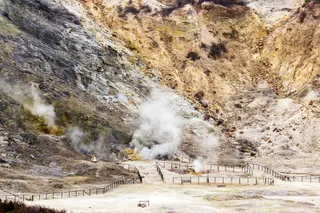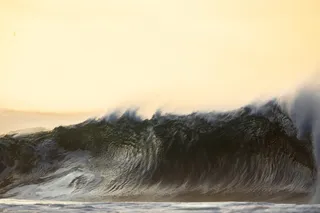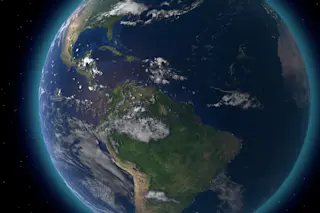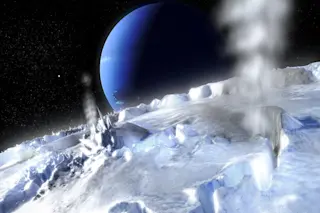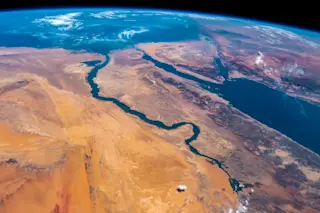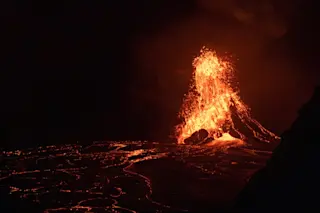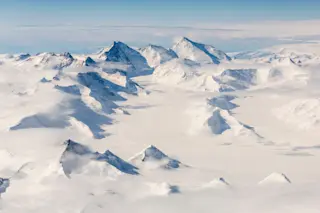I've seen a lot of murmuring on the interweb about the drilling currently ongoing at the Campi Flegrei in Italy. I wrote about this project back in 2009, so I thought I'd repost that article. This drilling at the Italian caldera is for scientific research and the chances of causing an eruption by drilling is very (very) small. The most recent news of the Campi Flegrei drilling project says the drilling has reached 200 meters with 500 meters / 1600 feet being the initial goal. Future drilling could drill down as far as 3000 meters / 9800 feet. Look for a new post later today! {This article was originally posted on November 10, 2009.}
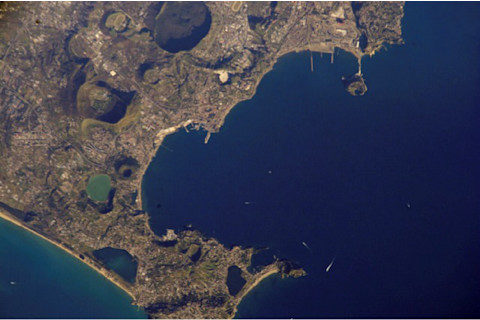
An undated ISS image of the Bay of Pozzuoli, showing much of the Campi Flegrei caldera. Image courtesy of NASA. One of the writing assignments I always enjoyed in high school was the "compare and contrast". You could sit back and look for stylistic differences between writers and texts - potentially offering signs about the nature of the writers motivations. I still find it fun - case in point, two article I read about the research drilling that is about to start at the Campei Flegrei in Italy. The Campei Flegrei is a large caldera system that most recently produced Monte Nuovo, a scoria cone on the north shore of the Bay of Naples. It also produced a very large eruption ~39,000 years ago that erupted ~150 km^3 (along with the Roman myths of the entrance to Hades). It has produced a number of VEI 3-5 eruptions over the last 4,000 years. Researchers from the National Institute of Geophysics and Volcanology's (INGV) Vesuvius Observatory in Naples plan to do some research, exploratory drilling up to 4 km into the caldera to look at the innards of the magmatic system - and to read the record of previous eruptions from the system. This depth of 4 km is thought to be much shallower than any magma chamber under the Campei Flegrei. Of course, there are some who might say that drilling into an active volcano like the Campei Flegrei is dangerous - and Dr. Buttner and Dietrich from Univ. of Wurzburg rightly point out that there is a minute chance that an explosive event might happen if the drill hit a pocket of vapor-saturated silica magma - however, the benefits of reading the history far outweigh this very remote chance of a game-ending eruption caused by the drill. Anyway, what does this have to do the articles? Well, one article I read (the first one I read, in fact) was in Popular Science. The other was in New Scientist (sent to be me by the folks at Blogging Pompeii). Talk about stark differences in science journalism! My notes on the Popular Science article read like a litany of science writing/volcano media frustrations:
Who are the "researchers"?
Who are the "critics"?
How deep will the drill hole go?
"Supercolossal"??
The drilling in Iceland was stopped because the rig broke, not because the fear of a giant eruption (as this implies).
The drill in Iceland did hit silicic magma - unlike what they say here!
The research is trying to "avoid" eruption? - rather we want to learn about previous eruptions to understand the likelihood of future eruptions.
Campei Flegrei is not Vesuvius!
Why is there a giant CGI eruption of Vesuvius(?) part of this article??
I could go on ... I was fuming: "What is wrong with you people?" I decided to read the New Scientist article to fan the flames of anger, but thankfully it didn't. The first thing I noticed is that the Popular Science article was more-or-less cribbed from the New Scientist (or some other primary source) - the same sentences and phrases appear in both. However, what seems to have happened is the Popular Science article chopped out all the specifics like who the researchers and critics are, the depth of drilling, the real "science" in the article. It left out the quotes from the scientists and their pros and cons. More or less, it stripped down the news of the drilling to: DRILLING WILL KILL US ALL. Thankfully, the New Scientist article at least shows some moderation in the fear mongering (right down to the toned down title and picture of - gasp! - the Campei Flegrei hydrothermal field instead of doomsday CGI volcano). It means we can all get back to the science here. Drilling in an active volcano for research or geothermal purposes isn't really anything new - we've done it at Hawai'i (where they hit magma), in Iceland (where they hit magma), at Mt. Unzen in Japan (where they drilled into the conduit), in the Philippines and more. Although a few drill rigs have been destroyed in the process, either through small explosions (and even smaller lava flows), none have lead to anything even close to a true "eruption" of the volcano. Our human drilling is nothing compared to all the geological processes that can make conduits for magma - faulting, explosions, volatiles - what we're doing is the equivalent of getting pricked with a tiny needle and worrying about the bloodloss. Sure, if you hit the exact right artery, you might be in trouble, but the chances are small for disaster. So, as I've suggested before, while it appears that drilling can increase seismicity, there doesn't seem to be a lot of good evidence that we can unleash an caldera-forming ignimbrite with our drilling ... maybe we just like to flatter ourselves about the effect we can have on the planet. However, buried in the New Scientist article is this little gem that I personally find much more fascinating. A paper by Roberto Isaia out in Geophysical Research Letters suggests that "hazard planners should prepare for eruptions in decades or less" (my emphasis) at the Campei Flegrei. Wow! This is apparently predicted partly due to 3 meters of inflation at Pozzuoli since the 1960s. Now, why isn't this the news here?



